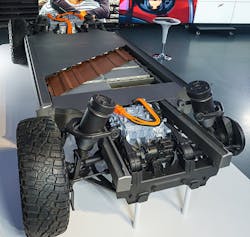Nikola Corp. has revealed that General Motors will be the automotive partner to produce its zero-emission pickup truck, the Nikola Badger, notable for having both battery-electric and hydrogen fuel cell options. Through the recently announced strategic partnership, GM will engineer, validate and manufacture the Badger at an undisclosed factory, using its Ultium battery system and Hydrotec fuel cell technology platforms.
GM takes an 11% stake in Nikola worth $2 billion and will earn more than another $2 billion from the contract manufacturing and various electric vehicle (EV) incentives. Production is expected by the end of 2022, a year later than expected.
Phoenix-based Nikola had already designed the pickup from the ground up, though the original powertrain and chassis will be eschewed in favor of one better suited to GM’s powertrain platforms, which includes the e-axle, drive train and inverters. The Badger will keep its current fit, form, finish and interior, along with certain infotainment and security features.
With the changing of powertrains, the previously released Badger specs have changed, mostly for the better. These are the new estimated specs:
- Peak HP went up 9% to 988 HP.
- Towing capacity improved 25% to 10,000 lbs.
- Torque decreased 8% to 897 ft. lbs.
GM will also be the exclusive supplier of hydrogen fuel cells for Nikola Class 7 and 8 trucks globally except for Europe.
“This strategic partnership with Nikola, an industry leading disrupter, continues the broader deployment of General Motors’ all-new Ultium battery and Hydrotec fuel cell systems,” said General Motors Chairman and CEO Mary Barra. “We are growing our presence in multiple high-volume EV segments while building scale to lower battery and fuel cell costs and increase profitability. In addition, applying General Motors’ electrified technology solutions to the heavy-duty class of commercial vehicles is another important step in fulfilling our vision of a zero-emissions future.”
Nikola founder and chairman Trevor Milton said on a press call the deal is a “win-win” for both GM, founded in 1908, and Nikola, founded in 2016, and which went public in June. Nikola (NKLA) shares climbed 40% based on the news.
“Nikola is one of the most innovative companies in the world. General Motors is one of the top engineering and manufacturing companies in the world. You couldn’t dream of a better partnership than this,” Milton stated. “By joining together, we get access to their validated parts for all of our programs, General Motors’ Ultium battery technology and a multi-billion dollar fuel cell program ready for production. Nikola immediately gets decades of supplier and manufacturing knowledge, validated and tested production-ready EV propulsion, world-class engineering and investor confidence. Most importantly, General Motors has a vested interest to see Nikola succeed.”
He asserted neither company’s power platform would be able to lower their component cost alone, making the team up the economically prudent call.
Milton said “utilizing the GM battery on this truck helps us reduce costs by over 30%.” That projects out to $4 billion in battery and powertrain cost savings over the next decade. Validating the chassis and powertrain alone may have cost Nikola $1 billion.
Big victory for GM
The most obvious benefit for GM is that $4 billion spelled out in the agreement, though the Badger provides another vehicle on which to grow its zero emission technology. The Chevy Bolt is GM’s lone EV as of 2020. Overall, GM plans on having 20 EVs by 2023.
An electric rebrand of the Hummer and the Cadillac Lyriq crossover will also use the Ultium, which will have battery capacity ranging from 50 kWh to 200 kWh. The battery tech will also rely on 70% less cobalt than competing batteries and have a higher density. These batteries will be manufactured in conjunction with LG Chem in Lordstown, Ohio, at a factory across the street from the sprawling plant GM closed in 2019 and sold to an electric pickup startup called Lordstown Motors. GM has a $75 investment in that company.
Barra made clear that electric vehicles were vital to GM’s future strategy when the company announced in Nov. 2018 that it would close down five North American plants (including Lordstown) to save $6 billion by the end of 2020, savings that would someday be invested in electrification. That someday is now, apparently.
Barra also said GM has “a well-defined technology roadmap that [they’re] following to get the cost per kilowatt hour down below $100 is just the beginning and we plan to go much lower.”
Heavy-duty Impact
The associated cost reductions should also positively impact Nikola’s impending Class 8 options, the Nikola One, Two, and Tre, as well as the NZT of-road utility vehicle. The electric Tre, a cabover ideal for urban deliveries, will be made in Ulm, Germany by Iveco, while the One and Two will be made at a factory in Coolidge, Ariz. As part of the deal, GM’s Hydrotec fuel cell will make its way onto Nikola’s heavy-duty trucks.
“I think entering class seven/eight truck market is a huge opportunity for us with fuel cells to commercialize [them],” Barra said on the press call. “We're also looking at other areas, whether it's in military, aerospace, etc, as we go forward. And all of that will help us learn improve the technology and get the cost down to make it practical to put eventually someday into a General Motors retail product.”





